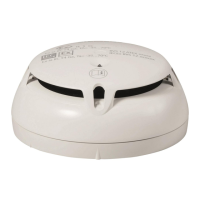Maintenance / repair
82
Building Technologies 007004_k_en_--
Fire Safety & Security Products 16.04.2009
7.3.1 Testing detectors with detector exchanger and tester
Testing detectors on a collective or addressed (FDnet, MS8) line is easiest with the
detector exchanger and tester FDUD29x. With the detector exchanger and tester,
the detectors can also be tested in operating mode without any problems.
A detector can also be switched to test mode with the detector exchanger and
tester. Detectors on a collective line or on an MS8 line automatically revert to
normal operating mode after 60 seconds in this case.
For detailed information, please refer to the operating instructions of the detector
exchanger and tester (documents 007227 and 009718).
7.3.2 Testing detectors without detector exchanger and tester
The fire detectors are highly resistant to deceptive phenomena. Optical fire
detectors thus recognize the immediate occurrence of smoke, as typically occurs
when testing with test gas, as a deceptive phenomenon and do not trigger an
alarm. This is desirable in normal operation; however, it does make testing with test
gas problematical.
To enable detector testing with test gas or with a hot air fan, the detector must be
switched to test mode. Testing with test gas or the hot air fan differs with
addressed and collective detector lines.
Addressed detector lines (FDnet)
On addressed detector lines, the detector or detector zones can be switched to test
mode on the control panel. Testing with test gas is then possible without problems.
Addressed detector lines (MS8)
Detectors on an MS8 line cannot be set to test mode from the control panel. Unlike
with the collective detector line, the detector is not allowed to be removed briefly
from the detector line and reinserted, otherwise all subsequent detectors will be
disconnected. Testing without a detector exchanger and tester is difficult,
specifically with smoke detectors.
Collective detector lines
Detectors on a collective line are automatically switched to test mode for 3 minutes
during startup and reset. A detector that has been newly inserted (or that has been
briefly removed from the detector line and re-inserted) is thus automatically in test
mode during the first 3 minutes.
To trigger a detector with test gas, normally 2 … 4 gas discharges at intervals of
approx. 2 seconds are required. When the detector is in test mode, activation
takes place after approximately 10 seconds.

